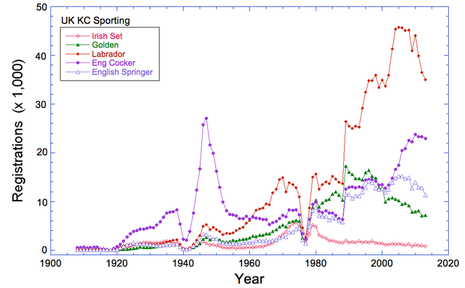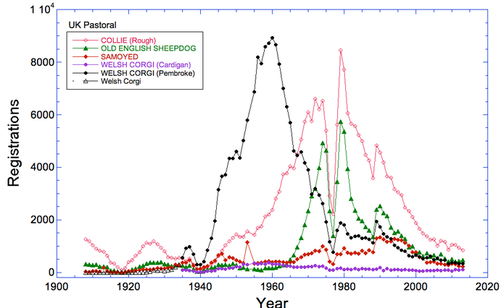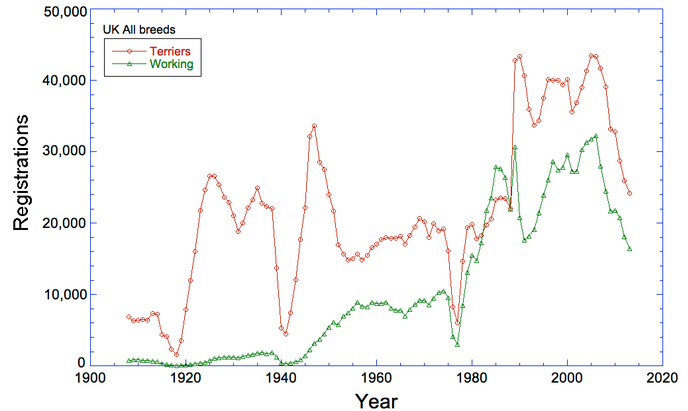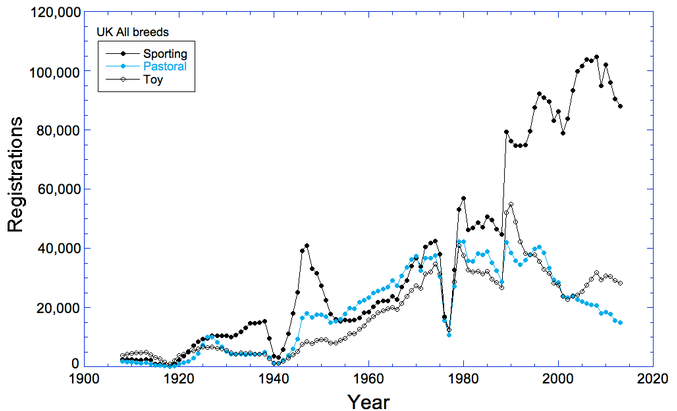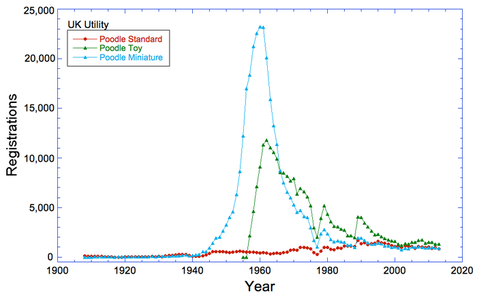The genetic status of a dog breed today was shaped by its history. The number of founder animals, population explosions and crashes, geographic separation, popular sires, and many other things have effects that shape the genetic trajectory of a breed.
A few days ago a breeder forwarded to me the population statistics for her breed in the UK, and to my surprise it contained not just the registration records her breed but for all the UK breeds back to 1908. Digging through data is like an archaeological investigation; you never know what you will find. I love discovery so I dove in, and I am truly astonished at the information in these tables and tables of numbers. Maybe this is all old hat to somebody out there, but it was a real eye-opener for me.
The data are just registrations by year with the UK Kennel Club. The database I was sent runs up to 2009, and I added the data to 2013 using the 10 year summaries available on the UK KC website. I graphed the registrations per year for each breed and also by groups. The numbers varied wildly by breed - Labradors are registering more than 40,000 dogs per year, while many breeds log fewer than a hundred. To save time I didn't want to draw separate graphs for every breed, so I tried to group them as I went, and as it happened this proved to be quite revealing. Some of the breeds should be graphed again on a different scale, but for now I hope that the information will be useful for most breeds. (The website location of the graphs is at the bottom of the page.)
The first thing that struck me as I started graphing was a dip in registrations between 1970 and 1980. It is very obvious in this graph of sporting dogs, looking a bit like somebody stuck their finger in the cake. As you will see, this dip appears in almost all of the breeds in every group. It is not a dip in popularity of a breed, but a very large, systematic drop in registrations. It doesn't seem to correspond to a war (you can see a dip around WW II in many breeds), and I'm at a loss to explain it. A plunge in the popularity of dogs? A postal strike? A rebellion against registration? I have no idea. It is not just the odd dip, but a steep decrease for several years followed by a rise over several years, usually to about the level of registrations before the crash. If anybody has an explanation for this, I would love to hear it. [A little homework turns up two possible explanations - a parvo outbreak in the 1970s and a severe economic downturn. More on the possible implications of those events later. (Sorry K, you were 11 hours and about 6 people too late to take credit for parvo. But keep playing - anyone can win!)]
The next thing that is so striking in these data really shouldn't come as a surprise. Many breeds have gone through not just the bottleneck in the late 1970s, but others as well and some were even more dramatic. The English Cocker was enormously popular at the time of WW II (graph above), when registrations for most breeds dropped. And surging with the English Cocker was an odd mix of other breeds - the English Setter, Pointer, Whippet, Norwegian Elkhound, Smooth Dachshund, Scottie, Cairn Terrier, Bedlington, German Shepherd, Pekingese, Chow Chow, Bulldog, Keeshond, and an amazing boom and bust in the Pembroke Welsh Corgi. In many breeds there was also a dip in registrations around the time of WW I (1914-1918).
Apart from these bottlenecks explained by major historical events, there were many very severe population explosions, crashes, and bottlenecks. The Yorkshire Terrier went from 26,000 registrations in 1990 to only 5,000 a decade later. The Pug has gone from 1,000 in 2003 to about 8,000 in little more than a decade. In French Bulldogs, registrations have gone from 700 to 7,000 in only 7 years, and the Bulldog is gaining ground fast as well. You will find other really remarkable shifts in breed popularity if you explore the graphs.
Most of the Working breeds, Terriers, and Pastoral breeds are all headed down. Registrations of German Shepherds have been dropping since before 2000, and the one herding breed on the upswing is the Belgian Malinois although registrations are still less than 200 per year. It's fascinating to see how surges in popularity of one breed mesh with the drop in registrations of another. In the late 60s, everybody wanted a Beagle, Basset, or Afghan, then just as quickly the registrations of those breeds dropped off. Weimaraners have been steadily dropping for the last 15 years, while Vizslas have been increasing steadily since 1990.
I don't know what to make of the Poodles. I have talked elsewhere about the explosive growth in the Poodle population beginning in about 1965, but the data for Poodles in the UK have scarcely a bump at that time. There was, however, a huge surge in popularity of Miniature Poodles in about 1950, and a smaller one in Toy Poodles about 5 years later; both were way down by 1975. [I'll be taking a closer look at the poodle data.]
There is lots to be learned in these graphs and I've only just begun to explore. If you understand a bit about population genetics, you will probably find them unsettling. You will also see that there are changes happening now in many dog breeds (decreases as well as increases) that breeders should recognize have the potential for producing long-term genetic damage to the breed if not managed. It would be great if there was a comparable database for dogs in the US, but I don't have one and the AKC no longer publishes their registration statistics. If it's because of falling numbers, they can see here that this is happening in the UK as well. But surely publishing only a list of AKC's "most popular" dogs each year only serves to drive the popularity of those breeds, to the detriment of the breeds at the bottom of the list. The UK is registering 25,000 German Shepherds a year, and 45,000 Labradors. A few thousand off each of those and distributed to the breeds at the bottom of the list would help many breeds that are really struggling with very low numbers. (At the same time, however, the numbers of both of those breeds are dropping, and it would be useful to know why.)
My apologies in advance if the graph of your breed would be better graphed on a different scale. In time they will all be redone, but I hope that you will nevertheless find them useful. And I want to know whose finger it was in the cake.
